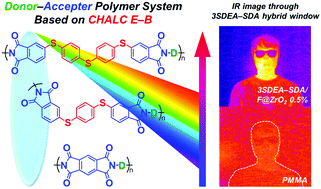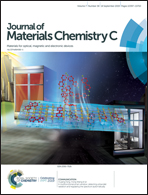Infrared transmitting polyimides based on chalcogenide element-blocks with tunable high-refractive indices and broad optical windows†
Abstract
We report herein on thermally stable polyimide (PI) hybrid optical imaging sensors based on chalcogenide element-blocks that can be advantageously used in light-weight optical materials, especially in infrared (IR) applications. A change in the length of chalcogenide element-blocks, which formed the building block backbone of PI, induced a difference in overall transmittance in the visible and near IR range of frequencies. The PI hybrids covalently bonded with zirconia displayed tunable refractive indices up to 1.79 at 532 nm along with an unprecedented transmission from the visible to the IR spectral region. The amine-functionalized zirconia nanofillers can also significantly improve the thermomechanical properties of the host PI due to the favorable interaction with the PI matrix. In particular, we demonstrate that PI hybrids can accomplish high-quality IR thermographic imaging of human subjects, and even visualize details of elaborate micropatterns. Consequently, the PI hybrids can be used to manufacture thermally robust and transparent optical lenses that are cost-competitive compared to the conventionally used inorganic types, thus offering advantages of improved processability, flexibility, reduced volume, and light-weight characteristics.



 Please wait while we load your content...
Please wait while we load your content...